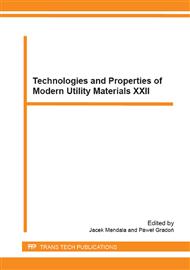p.79
p.87
p.91
p.95
p.99
p.103
p.107
p.111
p.115
Microstructure and Mechanical Properties of High Manganese TWIP Steel after Thermo-Forming Processes
Abstract:
In recent years, the leading scientific centres focus their research on improvement of mechanical properties of steels used for car manufacturing. These steels belong to a so-called 2nd generation of steels showing above-the-average plasticity while maintaining high strength. Thanks to these properties, they may be used successfully in automotive, armaments or railway industries for elements absorbing energy of a collision and ensuring high rigidity of a structure owing to their resistance to breaking. These steels are called TWIP (Twinning Induced Plasticity) steels based on their hardening mechanism. In this paper, results of studies on the influence of parameters of thermo-plastic deformation on selected properties and structure of an X45MnAl20-3V austenitic steel showing the TWIP effect are presented. Moreover, an analysis of influence of the deformation on the structure of the studied steel in tensile tests has been carried out. The studied steel was manufactured by classic casting to a concast mould, obtaining ingots with dimensions of 100×100 mm, then subjected to rolling in 4 roll passes to a final thickness of 12 mm and 3 mm. The finish-rolling temperature was 950°C and the sheets were cooled in 2 media, i.e. in air and in water. It was confirmed that the studied steel belongs to the TWIP group of steels, with mechanical twinning being the prevailing process of hardening during deformation.
Info:
Periodical:
Pages:
99-102
Citation:
Online since:
January 2015
Authors:
Price:
Сopyright:
© 2015 Trans Tech Publications Ltd. All Rights Reserved
Share:
Citation:


